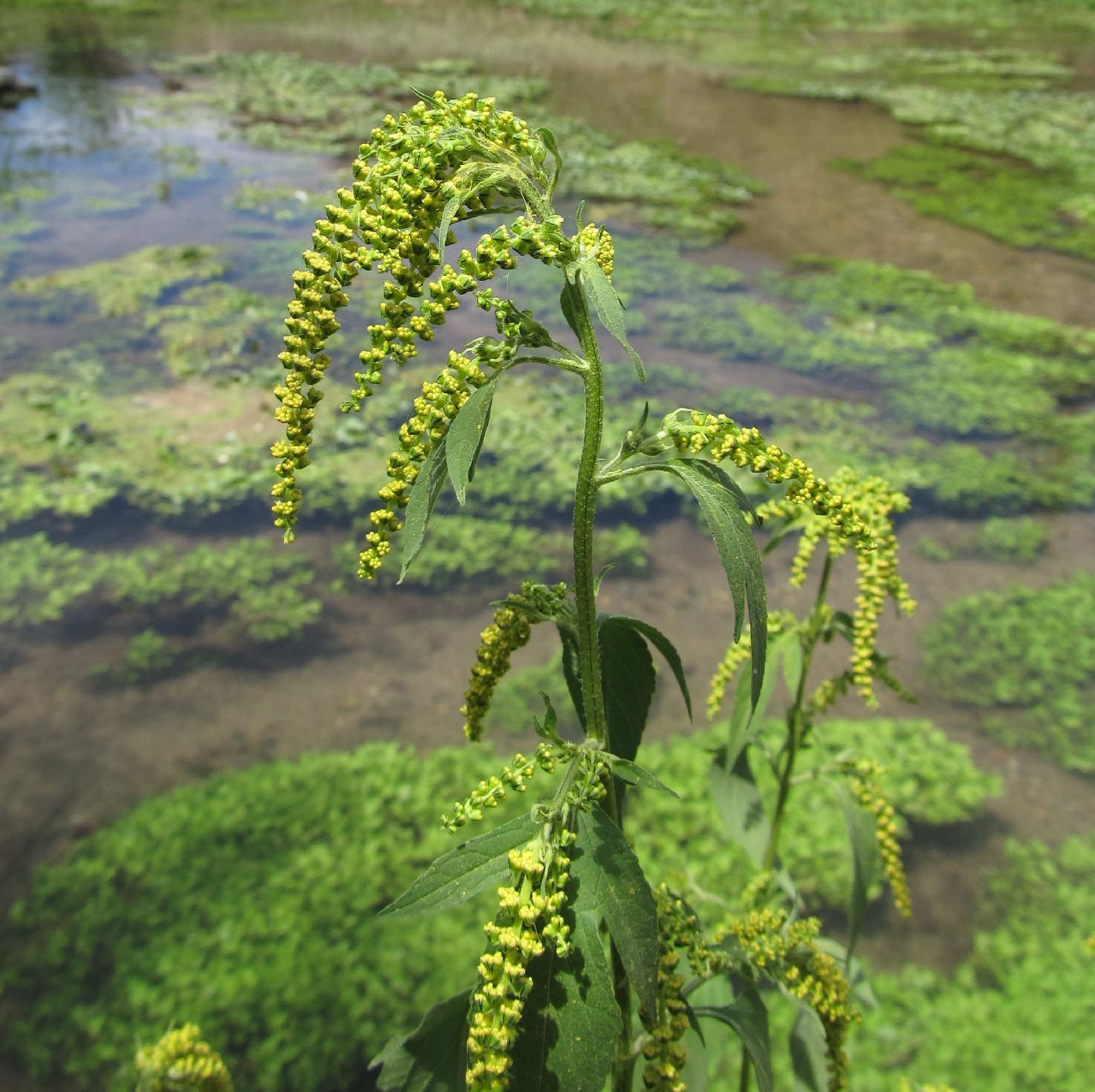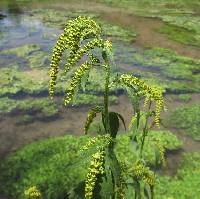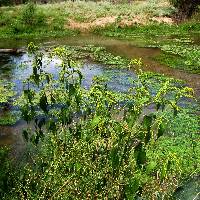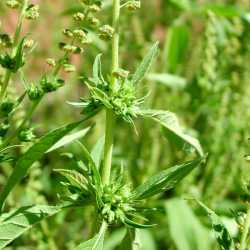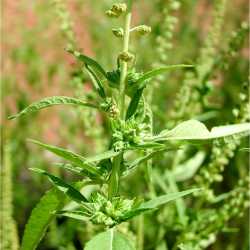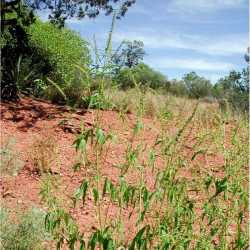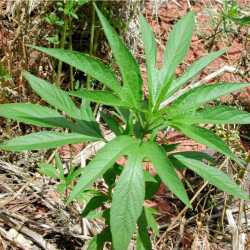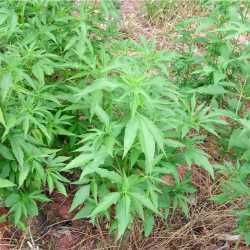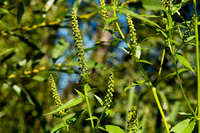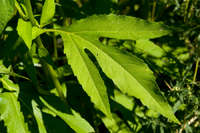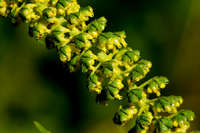Annuals, 30-150(-400+) cm. Stems erect. Leaves mostly opposite; petioles 10-30(-70+) mm; blades rounded-deltate to ovate or elliptic, 40-150(-250+) × 30-70(-200+) mm, usually some blades palmately 3(-5)-lobed, bases truncate to cuneate (sometimes decurrent onto petioles), margins usually toothed, rarely entire, abaxial and adaxial faces ± scabrellous and gland-dotted. Pistillate heads clustered, proximal to staminates; florets 1. Staminate heads: peduncles 1-3+ mm; involucres ± saucer-shaped, 2-4 mm diam., scabrellous (often with 1-3 black nerves); florets 3-25+. Burs: bodies ± pyramidal, 3-5(-7+) mm, glabrous or glabrate, spines 4-5, ± distal, ± acerose, 0.5-1 mm, tips straight (bases ± decurrent as ribs). 2n = 24, 48.
Flowering Jul-Nov. Disturbed sites, waste places, damp soils; 0-1600 m; Alta., B.C., Man., N.B., N.S., Ont., P.E.I., Que., Sask.; Ala., Alaska, Ariz., Ark., Calif., Colo., Conn., Del., D.C., Fla., Ga., Idaho, Ill., Ind., Iowa, Kans., Ky., La., Maine, Md., Mass., Mich., Minn., Miss., Mo., Mont., Nebr., N.H., N.J., N.Mex., N.Y., N.C., N.Dak., Ohio, Okla., Oreg., Pa., R.I., S.C., S.Dak., Tenn., Tex., Utah, Vt., Va., Wash., W.Va., Wis., Wyo.; Mexico (Chihuahua).
The name Ambrosia ×helenae Rouleau applies to hybrids between A. artemisiifolia and A. trifida. Hybrids between A. bidentata and A. trifida have been recorded. Ambrosia trifida may be no longer extant in British Columbia.
This ragweed, without doubt, occurs in every county of the state. It is usually abundant in the alluvial bottoms of streams. Found in low, open places in cultivated and fallow fields and woodland. It grows to giant size and J. M. Coulter records measuring a specimen 18 feet high. A form with entire leaves is often found growing with the species. I believe that it is a depauperate form of the species and it has no taxonomic significance.
Indiana Coefficient of Conservatism: C = 0
Wetland Indicator Status: FAC
Duration: Annual
Nativity: Native
Lifeform: Subshrub
General: Large annual herb, 30-150 cm but can be up to 2-3 meters tall; stem erect, solitary and unbranched; herbage papillose-strigose to hispid, can be glabrous below.
Leaves: Opposite and petiolate, the petioles 2-7 cm long; blades large, 4-15 cm long, palmately 3-5 lobed, the margins serrate; small leaves sometimes not lobed.
Flowers: Pistillate and staminate flowers in separate heads; all heads discoid; staminate heads pendant in terminal racemes; pistillate heads in clusters at the bottom of the raceme below the staminate heads. Staminate heads 3-25 flowered, the involucres shallowly or obscurely 1-3 lobed, each lobe with a black nerve extending from the center to the margin. Pistillate heads 1-flowered, the involucres 5-10 mm long, several-ribbed, with each rib ending in short spine, the spines forming a cycle around the stout, cone-shaped beak of the mature fruit.
Fruits: Burs pyramidal, 3-5 mm, glabrous or glabrate, with 4-5 spines.
Ecology: Found on roadsides and waste places, usually in moist soil; weedy but not particularly common; from 2,500-8,000 ft (762-2438 m); flowers July-October.
Distribution: Throughout North America.
Notes: Ambrosias are shrubs or herbs with unisexual flowering heads heads of all disk flowers, the female heads maturing into hard fruits or spiny burs. A. trifida is a tall weedy annual, distinguished from other Ambrosia spp. by its large, palmately lobed leaves.
Ethnobotany: Used externally for insect stings and infected toes; internally to treat fever, pneumonia, and diarrhea with bleeding; root chewed to drive away fear at night.
Etymology: Ambrosia is Greek for food of the gods, while trifida means cleft into three parts, referring to the leaf shape.
Synonyms: Ambrosia aptera
Editor: SBuckley 2010, AHazelton 2015
Coarse annual weed to 2(-5) m; stem spreading-hairy above, often glabrous below; lvs opposite, petiolate, ±scabrous, broadly elliptic to more often ovate or suborbicular, often 2 dm, serrate, palmately 3-5-lobed, or, especially in depauperate individuals, lobeless; staminate invols ca 1.5 mm, slightly oblique, unilaterally evidently 3-nerved; fruiting invols 5-10 mm, several- ribbed, each rib ending in a tubercle or spine; 2n=24. Moist soil and waste places throughout our range, s. to Fla., w. to B.C. and n. Mex. (July) Aug.-Oct. The common form in most of our range is var. trifida, with the petioles of at least the upper lvs ±wing-margined, and the ribs of the fr ending in short spines. (A. striata) From s. Ill. and Mo. to Miss., Ariz., and n. Mex. is found var. texana Scheele, with wingless petioles, and with the ribs of the mostly smaller fr ending in blunt or almost obsolete tubercles. (A. aptera)
Gleason, Henry A. & Cronquist, Arthur J. 1991. Manual of vascular plants of northeastern United States and adjacent Canada. lxxv + 910 pp.
©The New York Botanical Garden. All rights reserved. Used by permission.


